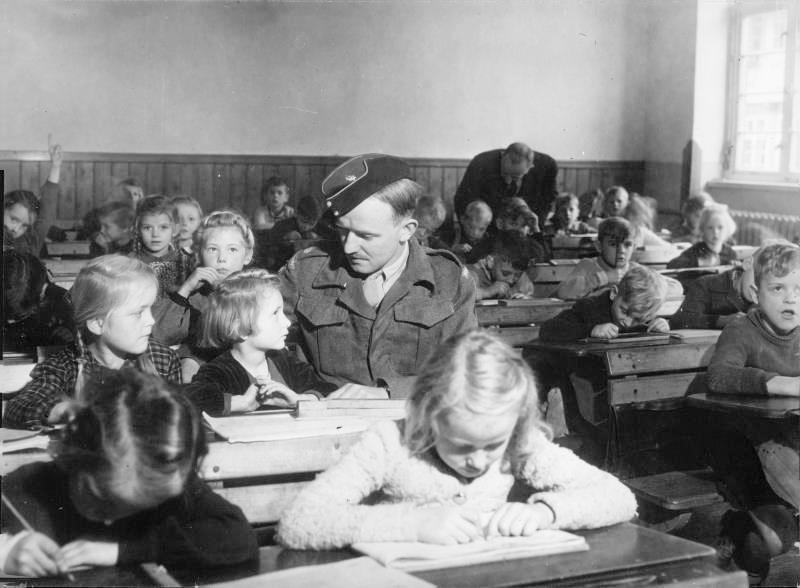
British Occupation Zones of Germany (1945-49)

Figure 1.-- German schools had ceased operating as the Allies closed in on the Reich. This began as the Germans comenced evacuating the cities as the Allied strategic bombing campaign intensified. Theoretically thechildren were to be taught at their evacuatiion sites. The children were, however, put in the hands of Hitler Youth and educatiion was niot a high priority. Finally with cities bombed out, schools in the cities began to close. Many schools closed in lkate-1944 and early 1945. It thus became a priority to get the schools running again. Destroyed and damaged school buildings were a problem. An even greater problem was finding teachers. The NAZIs had throughly NAZIfied the German educational system. Teachers who had been openly anti-NAZI were arrested. And those who showed any lack of enthiusiam were dismissed. So the Allies did not want the enthusiatic NAZIs left in the classroom. A de-NAZIfication campaign was launched, but it would be some time before teachers coiuld be certified. Thus we see British soldiers doing claassroom duty. The press captuion here read, "British Military Government 'Fathers' the New Germany: Major D.J. Stevens, responsible for education questions a little girls during a tour of the schools in the Dannenburg area." The photograph was taken in 1945.
|
|
Britain was the only one of the three major Allied powers to have fought the NAZIs from the begining of the War. The British occupation zone was located in the north. The British Military Government (Control Commission for Germany – British Element--CCG-BE) was headquartered in Bad Oeynhausen. Field Marshal Montgomery was the first British Military Governor. Montgomery had served as a young officer in the British Army of the Rhine (BAOR) after World War I as part of the occupation of the Rhineland (Cologne and surrounding areas). Their task had been to ensure compliance with the Versailles Peace Treaty. Montgomery decided that he would take the approach the occupation as if it were a military operation. The first major priority was the ‘Battle of the Winter’ and set about securing food, work and homes for the Germans. He had the British Army to work with and the civilian CCG-BE which had been established in Britain and transferred to Germany (July and August 1945). The northern zone was not based on any Allied decision. The north was the operational area of British and Canadian combat units when they fought their way into the Reich. The British zone included Hamburg, Schleswig-Holstein, Lower Saxony, North Rhine-Westphalia Hannover, parts of the Rhineland, and Westphalia. Some of these had their borders changed or merged with the states before the occupation. While the Britih and Canadian forces were primarily in the north, there were unit in other sections of Grmany, including areas in the Soviet Zone. These forces with drew into the British Zone (July 1945). They ceded some small sections of their zone to the Soviets.
Bremen and Bremerhaven in the north were turned over to the United States so that they had a port. The Rhineland-Palatinate was to be a part of the British Zone, but they turned it over to the French. At Yalta the Americans and British pushed for a French occupation zone. Stalin objected, but relented as long as it would be formed from parts of the Anmerican and British zones. The CCG-BE did some border changes such as restituting the traditional German state of Hamburg. We are not sure why these border changes were made.
The British redeployment to turn ovr the restituted traditional German state of Bremen to the Americans (1947). It thus became an American exclave in the middle of the British zone (1947). We are not sure why this occurred.
CIH -- WW II

Navigate the CIH World War II Section:
[Return to Main Individual Western occupation zones page]
[Return to Main Western occupation zones page]
[Return to Main Western occupation zones page]
[Return to Main World War II German occupation page]
[Return to Main World War II German aftermath page]
[Return to Main Cold War page]
[About Us]
[Aftermath]
[Biographies]
[Campaigns]
[Children]
[Countries]
[Deciding factors]
[Diplomacy]
[Geo-political crisis]
[Economics]
[Home front]
[Intelligence]
[Military forces]
[POWs]
[Resistance]
[Race]
[Refugees]
[Technology]
[Totalitarian powers]
[Bibliographies]
[Contributions]
[FAQs]
[Images]
[Links]
[Registration]
[Tools]
[Return to Main World War II page]
[Return to Main war essay page]
[Return to CIH Home page]
Created: 9:40 AM 9/10/2018
Last updated: 9:40 AM 9/10/2018



